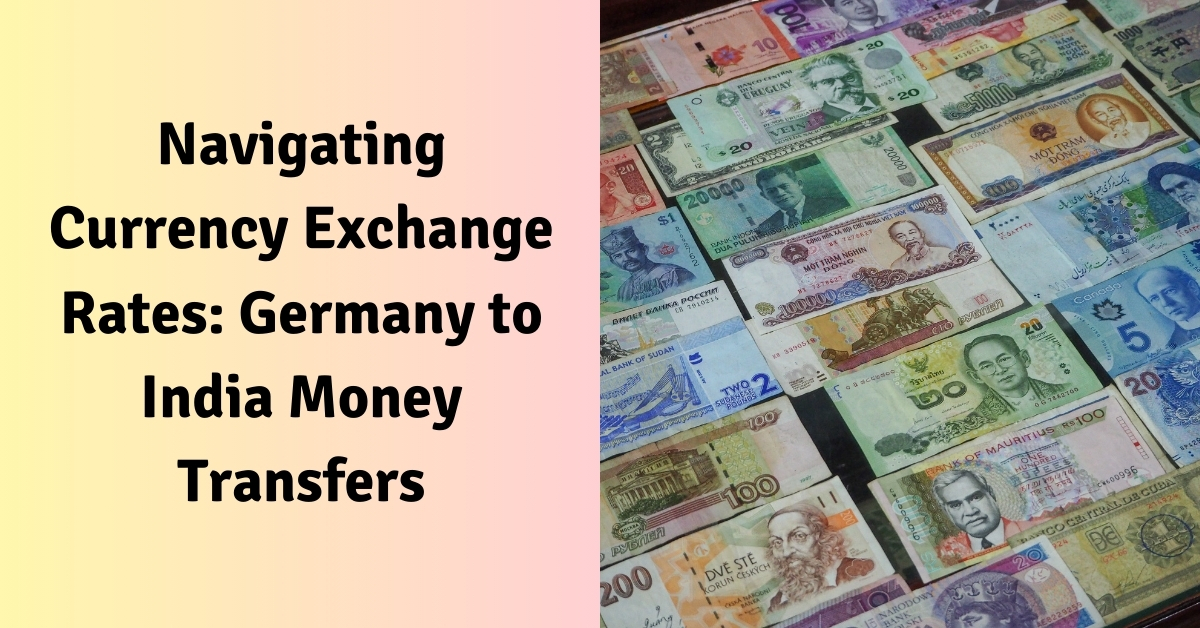Navigating Currency Exchange Rates: Germany to India Money Transfers

Picture this: You’re transferring money from Germany to India, perhaps to assist your family or invest in property. Despite having done this numerous times before, you’re taken aback when you notice the received amount is considerably less than anticipated.
What’s the cause?
This unexpected discrepancy often stems from fluctuating currency exchange rates.
Are you aware that millions of euros are sent from Germany to India each year? These transactions are vital for numerous families and businesses. But have you ever wondered how much money is gained or lost due to shifts in the currency exchange rate?
In this article, we’ll explore the realm of currency exchange rates, examine the factors that influence them, comprehend their effect on money transfers, and offer some advice on securing the best rates.
The Mechanics of Currency Exchange Rates
The foreign exchange market, or Forex, functions like an enormous currency bazaar. Countless individuals are constantly buying and selling currencies, causing prices (exchange rates) to fluctuate.
- High Demand Equals High Value: When many people desire euros (demand increases), the euro becomes “stronger” compared to the rupee, resulting in more rupees per euro.
- Low Demand Leads to Lower Value: The reverse occurs when fewer people want euros (demand decreases).
Understanding Buying and Selling Rates
Banks and currency exchange businesses operate with two rates:
- Buying Rate: The price they offer for your foreign currency (e.g., euros).
- Selling Rate: The price they charge you to purchase foreign currency (e.g., rupees).
The gap between these rates constitutes their profit.
The Mid-Market Rate
The mid-market or interbank rate is the midpoint between the buying and selling rates. It provides the most precise reflection of a currency pair’s actual value.
While most money transfer services and banks add a margin to the mid-market rate, being aware of this rate can help you recognize fair exchange rates.
Factors Influencing Currency Exchange Rates
Several elements can cause currency exchange rates to fluctuate. Let’s examine some of the most significant ones.
- Economic Health: A country’s economic performance greatly influences its currency. Stable politics, low inflation, and robust growth strengthen a currency (consider Germany’s euro). Conversely, economic weakness in India can weaken the rupee.
- Interest Rate Dynamics: Interest rates engage in a tug-of-war. Higher rates in Germany compared to India make the euro more appealing to investors, potentially driving up its value.
- Inflation Impact: Inflation erodes purchasing power. If prices rise more rapidly in India than in Germany, the rupee weakens as it buys less.
- Market Influencers: Speculators can trigger short-term swings. If traders believe the euro will appreciate, they might buy euros, pushing the price upward.
- Global Events: Significant world events such as wars or natural disasters can create uncertainty, leading to sudden changes in exchange rates.
The Impact of Exchange Rates on Money Transfers
Currency exchange rates directly affect the amount of money received in India when transferring funds from Germany. Let’s explore how this impact manifests.
1. Direct Effects on Transfer Amounts
Consider this scenario: if the currency exchange rate of the euro to the Indian rupee is 90 today, sending €1000 would convert to ₹90,000. However, if the rate drops to 85, the same €1000 would only convert to ₹85,000. Such fluctuations can significantly alter the received amount.
2. Hidden Fees and Charges
Some money transfer services might offer seemingly attractive rates but conceal fees within less favorable exchange rates. It’s crucial to compare different providers and be aware of hidden costs. Always check the full breakdown of fees to ensure you’re getting the best deal.
3. Timing of Transfers
Timing is crucial when making money transfers. Exchange rates can change rapidly, so transferring funds at the right time can help you secure a better rate. Monitoring rates and using rate alerts can help you identify the best time to send money.
Tips to Secure the Best Exchange Rates
Obtaining the best currency exchange rate can save you money and ensure that more funds reach their intended destination. Here are some practical tips:
1. Research and Compare Providers
Not all money transfer services offer identical rates or charge the same fees. Invest time in researching and comparing different providers. Look for those with transparent fees and favorable exchange rates. This will help you find the most cost-effective option.
2. Utilize Rate Alerts and Forward Contracts
Many money transfer services offer rate alerts to notify you when the exchange rate reaches your desired level and forward contracts to lock in a favorable rate for a future transfer, helping you secure better rates and avoid unfavorable fluctuations.
3. Avoid Unfavorable Exchange Rate Times
Certain times of the day or periods of economic uncertainty can result in less favorable exchange rates.
By staying informed about global events and market conditions, you can avoid making transfers during volatile periods and wait for more stable times.
Conclusion
Sending money from Germany to India?
Understanding currency exchange rates is essential! We’ve covered everything from the basics of exchange rates to practical tips for getting the best deals.
By staying informed and proactive, you can confidently navigate the world of currency exchange and maximize your money transfers.
So, remember these tips next time and take control of your experience! Happy transferring!
Frequently Asked Questions
1. How are currency fluctuations managed in money transfers from Germany to India?
Ans- Currency fluctuations are managed through various strategies such as hedging, using forward contracts, and setting up regular transfers to average the exchange rates over time. Money transfer services also offer rate alerts and notifications to help users lock in favorable rates.
2. What strategies optimize the value of transfers despite exchange rate changes?
Ans- To optimize the value of transfers, individuals can:
– Compare rates across different providers to find the best deal.
– Use forward contracts to lock in a favorable rate for future transfers.
– Set up rate alerts to transfer funds when the rate is most favorable.
– Time transfers to avoid periods of high volatility.
3. How are transfers timed to leverage favorable exchange rates when sending money to India?
Ans- Transfers are timed by monitoring exchange rate trends and using rate alerts provided by money transfer services. By staying updated on market conditions and economic events, individuals can choose the most advantageous times to send money, ensuring they benefit from higher exchange rates.
4. What criteria inform the selection of transfer services concerning currency exchange rates?
Ans- When selecting a transfer service, consider the following criteria:
– Transparency of fees and exchange rates.
– The offered currency exchange rate compared to the mid-market rate.
– Availability of tools like rate alerts and forward contracts.
– User reviews and reputation for reliable and timely transfers.
– Customer support and service quality.
5. How do individuals typically stay informed about exchange rate trends for transfers?
Ans- Individuals stay informed about exchange rate trends through:
– Financial news websites and economic reports.
– Currency converter apps and tools.
– Subscription to newsletters from financial institutions or transfer services.
– Following expert analysis and market trends on financial forums and social media.
6. How do geopolitical events impact the EUR to INR exchange rate?
Ans- Geopolitical events, like conflicts or political instability, can cause big changes in exchange rates. This means the amount of money you receive in India can vary a lot based on these events.
7. How do exchange rate margins affect the amount I get in India?
Ans- Exchange rate margins are the difference between the rates banks or services buy and sell currency at. A larger margin means you get fewer rupees for each euro you send. Checking these margins helps ensure you get a fair amount.
8. Are there regulations or taxes affecting transfers from Germany to India?
Ans- Yes, there are regulations and taxes that impact transfers. In India, the Foreign Exchange Management Act (FEMA) applies. Transfer services might also charge additional fees or taxes, affecting the final amount received.
9. How do banks’ and online services’ exchange rates compare?
Ans- Banks often offer less favorable exchange rates and higher fees compared to online money transfer services. Online services may provide better rates, but their fees can vary. Comparing both can help you get the best deal.
10. What tools can help manage exchange rate risks?
Ans- To manage exchange rate risks, you can use:
– Currency converter apps for up-to-date rates.
– Rate alerts to notify you of favorable rates.
– Forward contracts to lock in future rates.
– Financial news and economic calendars for market insights.



